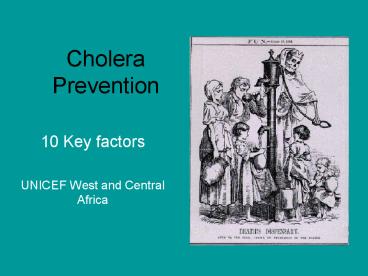Cholera Prevention PowerPoint PPT Presentation
1 / 15
Title: Cholera Prevention
1
Cholera Prevention
- 10 Key factors
- UNICEF West and Central Africa
2
OBJECTIVE OF NORWAY INITIATIVE
- Develop systems for cholera prevention and
outbreak response and to extend the benefits over
a longer time frame to reduce diarrhoeal disease
incidence.
3
1. What are the symptoms?
- Very rapid onset of vomiting and diarrhoea with
large volumes of very watery (rice water type)
stools (gt3 times a day) - Severe de-hydration, low pulse, undetectable
blood pressure, sunken eyes, wrinkled hands and
feet - Slow recovery of shape after depression of skin
- No urine output
- Laboratory confirmation but count all suspected
cases and treat
4
2. How is it transmitted?
- It is caused by a bacterium (Vibrio cholerae)
which lives naturally in brackish/freshwater
amoeba, and is transmitted through - - Unsafe water (7/8 investigations in Latin America
identified this as a major route) - Unwashed fruit and veg (or washed in bad water),
left over rice not re-heated (3 investigations
Lusaka 2004), - Lack of handwashing (food preparation, hand
shaking, childcare) - Cooked and uncooked sea food vibrio survives
light cooking (2 investigations)
5
3. Who is most at risk?
- Those living near lagoons / low lying areas with
fresh/ brackish water/ fishing populations - With unsafe water sources
- With poor faecal disposal practices
- With poor personal hygiene
- With poor food hygiene (esp. moist food of
neutral acidity) - Close to cholera patients in early stages
(hyper-infectivity) and dealing with bodies
6
4. When does cholera become epidemic?
- After heavy period of rainfall
- When water temperatures rise
- When normal diarrhoeal incidence increases
- Endemic cholera with good sanitation needs
permanent source of vibrio, but with poor
sanitation higher secondary transmission can
maintain endemic status
7
5. How long does it take?
- Incubation period 2hrs-5 days
- Infection 7-14 days, but most people do not
become ill or show any symptoms - Only about 10-20 of infected people show
moderate or severe symptoms. - Moderate symptoms difficult to differentiate from
other types of acute diarrhoea - Group O blood group highest risk
8
6. How is it treated?
- Greatest risk in first 24 hours, so re-hydrate as
soon as possible - Normally ORS (rice- rather than glucose-based
reduces purge rate,- sodium or gt 75mmol/l) - If vomiting, give intravenous fluid replacement
(eg Ringers lactate) extreme cases. - Give food as soon as patient can take it
- Extreme cases only should have 1-3 days
antibiotic (esp doxycycline single dose) to
shorten illness, when vomiting stops
9
7. How is it prevented?
- Blocking routes of transmission water
disinfection (source and /or household), hand
washing, sanitation, good food hygiene and
well-cooked - Cholera vibrio doesnt like acid environment
(block with acidic water eg. With citrus juice,
healthy stomach acid levels, acid food) - Oral vaccine (Dukoral) only for IDP setting
10
8. What proportion will die?
- Most people who die, do so within the first day
of symptoms appearing - Without any treatment about 50 of people survive
- With adequate re-hydration less than 2 will die
- With good surveillance, rapid establishment of
re-hydration, and anti-biotics for worst cases,
almost all deaths can be avoided (lt0.2 die)
11
9.Risky cultural practices/ beliefs
- The following beliefs about causes of cholera may
reduce effectiveness of key messages - - Witchcraft, eye, wind, climatic change cause the
sickness - Childrens stools are not dangerous
- Soap is believed to wash away luck
- The following practices increase risks
- Anal washing is often not followed by
hand-washing - Handshaking transfers bacteria directly from one
person to the next - Burial ceremonies may spread disease
12
10. What are Key Messages?
- Bad water is one source of cholera (disinfect
source or stored water) but others, especially
contaminated food (clean and cook well) and
associated lack of hand washing (essential times
and methods for handwashing) should also be
highlighted - Rapid transfer to clinics or use of ORT corners
speeds up treatment and reduces cross infection. - Re-hydration as early as possible saves the most
lives- water quality in OR is of little
importance - Good surveillance systems can identify causes and
reduce infection rates
13
Africas global dominance?
14
West Africa League Table
15
Typical cholera curve
Endemic 1. Cholera reservoir, constant or
sporadic few cases Epidemic. Triggered by factors
in 4. reaches peak and then preventive measures
dominate Endemic 2. Continued levels higher than
endemic 1 while person to person infection
continues

